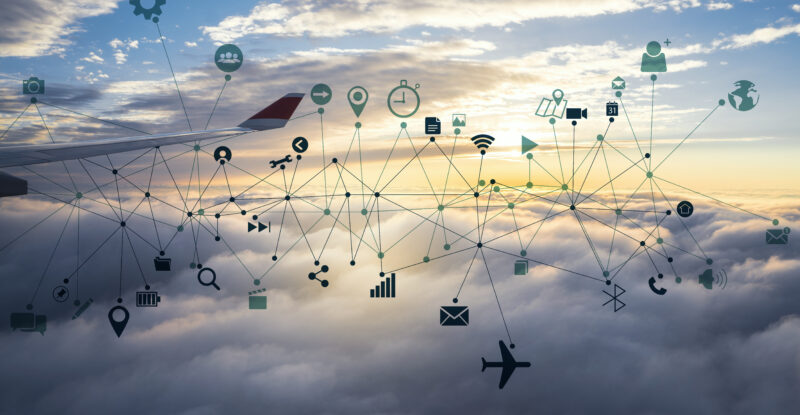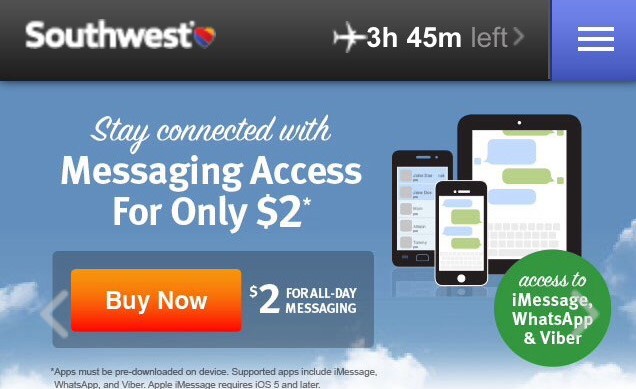 Gogo was first on the scene with a mobile messaging data package, offering limited services to customers at a lower price than a typical Internet access package. In recent months other providers have joined the fray, offering up lower priced plans in the hopes of increasing take rate (and revenue) while not scaring off passengers with high-priced connectivity. But the results are inconsistent and, in some cases, questionable in value.
Gogo was first on the scene with a mobile messaging data package, offering limited services to customers at a lower price than a typical Internet access package. In recent months other providers have joined the fray, offering up lower priced plans in the hopes of increasing take rate (and revenue) while not scaring off passengers with high-priced connectivity. But the results are inconsistent and, in some cases, questionable in value.
Southwest Airlines and Global Eagle Entertainment recently introduced a $2 plan for messaging, including access to WhatsApp, Viber and iMessage. Much like the carrier’s $8 full Internet access plan, the messaging product works for the whole travel day across multiple flights. The Gogo package offers access to similar applications and the company advertises it as costing less than $3, though it is typically sold on a per-flight basis, not as a day pass.
Other providers see the opportunity differently; they’re still hoping to attract mobile users at a lower price point but also offer access to a more full-featured suite of applications and resources.
For instance, a number of airlines operating with the Panasonic Avionics Ku-band system have launched limited consumption plans at a variety of price points.
Panasonic customer Air Europa offers 15 megabytes for 7 euros. Eurowings’ ‘social media package’, on the other hand, delivers 10 megabytes of data for 3.90€. That’s one of the smaller megabyte packages available.
@thatjohn Remember your outrage over Scoot’s “social-lite” 20MB wifi plan? Eurowing’ “social media package” is 10MB for 3.90€. Half the data
— Jason Rabinowitz (@AirlineFlyer) May 26, 2016
The 20 megabyte package from Scoot isn’t much better in total bandwidth, though it remains cheap at $5. Scoot’s limited service plan also comes with a speed cap on service in addition to the bandwidth limit. On the plus side, burning through the data allowance will take a bit longer; with the 64 kbps cap it should take passengers at least 45 minutes to use up the allocated data. But that’s not a good user experience and is likely to have users refreshing more. The Scoot service is positioned as follows:
Optimised for messaging and chat services as well as light surfing, “Social-Lite” costs just US$5 for 20MB of data at 64kbps surfing speed. It complements Scoot’s existing inflight Wi-Fi plans on its Boeing 787 fleet, priced attractively at US$11.95 for one hour, US$16.95 for three hours and US$21.95 for 24-hours, without any cap on data consumed.
Airlines and Wi-Fi providers want passengers to use the service and have a good experience. But how far can you get in a social media application with one of these megabyte deals? Not very far. Open up Instagram and click on the “explore” icon. That should use up more than two megabytes with a single click. Ouch.
I did some testing knowing what apps were running on my phone and how to prevent them from accessing the connection; most users do not know – and should not need to worry – about such considerations. Twitter is less data hungry while Facebook is on par with Instagram in my testing.
Separately, Thales (nee LiveTV) was among the first to offer a split tier plan for inflight connectivity – passengers could choose ‘basic’ access for half the price of the regular hourly Internet service fee. The basic plan was marketed for email and web use but the dynamics of media consumption changed sufficiently in a short period of time, and so the offering has become only marginally useful.
How should users be thinking about these packages and the pricing? Panasonic’s David Bruner continues to believe that finding the right price point and megabyte allocations is an iterative process, though one which depends on just how expensive is the wholesale bandwidth.
“They have different price points that are built around consumption, trying to hit certain price points for different customers. How many megabytes they assign to each is kind of a cost from us versus what they want to charge the customer. I think you will see airlines adjusting that. As their price decreases from us they will pass that on to passengers. We are making it cheaper for them, they will be able to pass that on to their customers,” he says.
So prices may come down and as that happens consumption will go up. In the interim, there are plenty of questions about just what is the demand and who will be paying per megabyte, especially with the limited utility of that truncated connection.













